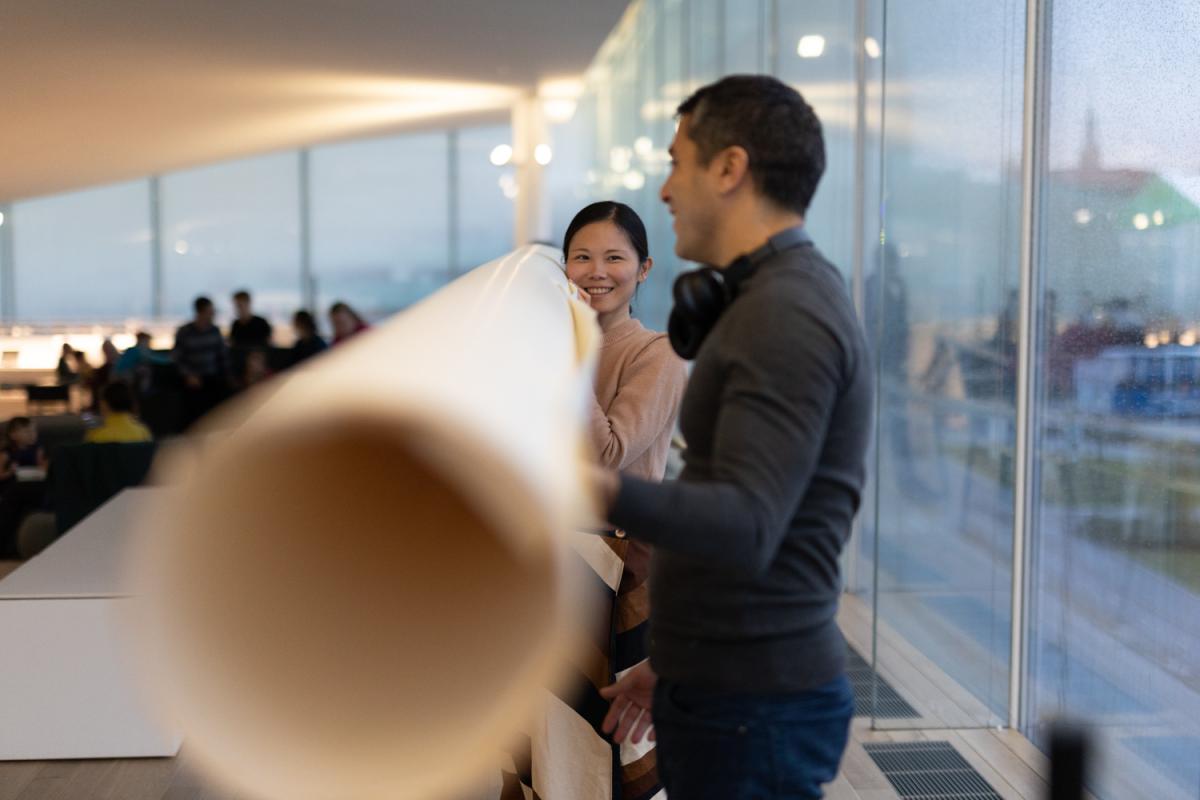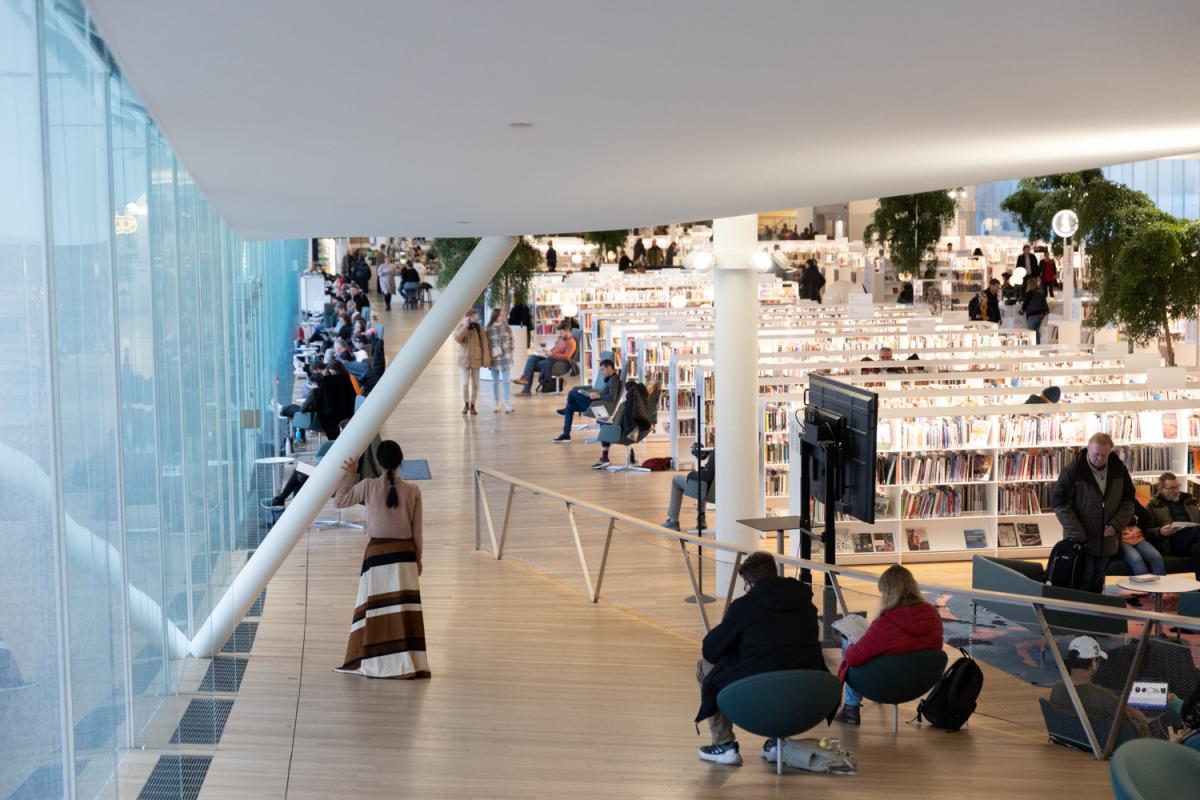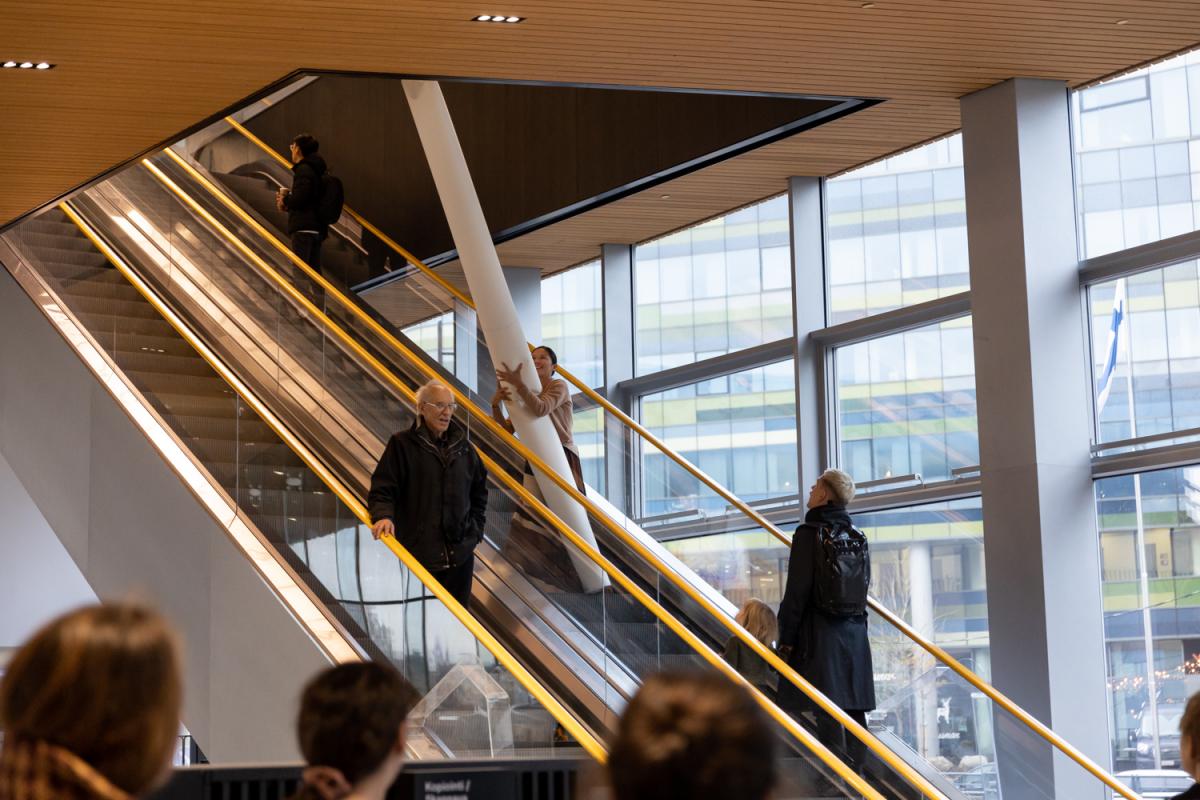A moving pillar, a living archive
A one-week residency project at Helsinki Central Library Oodi facilitated by Urbanapa. Written by Yun-Chen Chang, student in Live Art and Performance Studies.

Fascinated by Helsinki Central library Oodi with its inspiring architecture, diverse knowledge productions and social activities, I investigated my embodied knowledge in conversation with the existing knowledge system in the library. Oodi hosts so many kinds of knowledge, skills, purposes, functions, movements and bodies in a fluid and shared space. I wondered how performance art could also be hosted here. As I am interested in seeing the body as a living archive, how would I enact my embodied archive, particularly my sculptural approach to objects and my body, in dialogue with live situations in a public library? How could a living archive and embodied documentation intervene the social space for reading, learning, working, playing, resting, meeting, sharing, making and
producing knowledge?
Starting from observation, I browsed through different sections and categories, noticed the book shelves’ height and the ceiling’s fluid shape, walked on slopes and stairs, greeted Bucida buceras trees, immigrants from Central America, and watched how people circulated or stayed in one position. I assembled a 4-meter-square cardboard and rolled it up into a paper pillar. Initiating an architectural dialogue with the pillars, ceiling, shelves and other structures in the building, I paid great attention to how I held or carried the paper pillar, how it gave me the weight and momentum, how it came into contact with the building and how it made me perform in the public space.
Another embodied practice I carried out in relation to the site was the documentation of my sliding body. I unrolled the paper on the slope at a far end of the library. With one pencil in hand, I documented how my body slid, fell and rolled down the slope. From the top to the bottom, I repeated the sliding in different positions and trajectories, which caused different levels of friction and speeds. When I almost came to stillness, tiny movements still occurred in the body or the paper. Traces of sliding derived from breathing, relaxing the body into the floor, listening to movements and staying playful with decisions. Traces overlapped. Later documentations were superimposed on earlier ones.

An architectural dialogue turned into social intervention
Walking slowly and staying still with a 4-meter-tall paper pillar, I explored different possibilities related to the site and the relational encounters that could occur in it. I became more aware of my surroundings in order not to hit or shock anyone on my path. My existence with a tall paper pillar revealed personal and social bubbles in the public space as people raised their heads to witness the movement. People noticed the movement when hearing the paper pillar’s low dragging sound or sensing something slowly approaching them. Others ran into it while looking for books and passing by. I saw smiles, curiosity and confusion in different distances. A few teenagers found it amusing when they woke up from their naps and immediately saw a tall pillar in front of them. A few kids followed and observed me closely, showing great curiosity for the tall creature. Perhaps because the pillar looked heavy, some adults came and asked if I needed help to carry it around.
My presence with the paper pillar didn’t seem to fit into any functional purpose in the public library. My slow movement attracted some active engagement from the public. Among the people who came to ask if I needed help, one person approached me with an anxious look. He wanted to help me accelerate my movement with the pillar. Showing one direction, I followed his lead. Almost reaching the end of the path, he turned to me and asked if it was my destination. I replied, “If you think it is the place, I will stay.” Apparently having no clear destination frustrated him to some extent. He decided to leave me there and walk away. Being in the space with no particular function or purpose seemed to cause some restless reaction.
An accident turned out to be surprisingly beautiful
During the performance sharing on the last day of the residency, the paper pillar was crumbled by the low ceiling when I was taking the audience by escalator from the ground floor to the top. A loud crumbling sound surprised both the audience and me. I had to react to the situation right away, turned the pillar upside down and performed with its crippled and unstable foot. I became more attentive. It could stand on its own before, but then it needed me to stand. I wouldn’t have experienced this vulnerability without this accident. The crumbled end of the pillar became like a brush. It gave a different texture to the floor. The duet became closer while dancing around the space.

I decided to let the audience choose themselves where to stand and watch the moving pillar. A small audience attracted more people staying and witnessing, which gave me a different energy. Although I already did my practice among library users and there were many witnesses, I somehow had the pressure and pleasure to share some essences of my research with dedicated audience. I enjoyed the time walking with the crippled pillar, paying great attention to different relations with the space and the public. I had a narrative in my path, but as I didn’t demand the audience to follow me closely, they witnessed the whole situation from many different angles. That was the beauty of framing and
interpreting, but then I asked myself whether I could also express some thoughts more explicitly and whether showing the audience how I framed some space was essential to the process.
When sharing how I documented my sliding body, I was not as relaxed as I had practiced it alone. The sliding could be slow, and I could appear still for some time. With the attention from the audience, certain thoughts like “Is it boring?” “They probably already got the idea.” would pop up in my mind. How many times should I do it? How many different ways of sliding and documenting should I try? After finishing the sliding documentation, I rolled the paper back to the pillar shape and slid down with it to the bottom of the slope. When we slowly got back to our feet. Someone came to ask if I needed help, and he led me a long way to the other side of the library. Soon another person came to ask if I needed help, and he led me down to the ground floor.
When performance
The master’s programme in Live Art and Performance Studies (LAPS) was launched in 2001 as a Finnish-language degree programme, Esitystaiteen ja -teorian koulutusohjelma. Since 2013, LAPS has been an English-language, international and residential MA programme based in Helsinki. The objective of the programme is to enable artists coming from different environments, classes, cultures and upbringings to focus on their work, develop their research and map out the future of their artistic practice. This blog discloses the various aspects of the LAPS programme, from individual notions and statements by students to providing background for LAPS MA thematic interests.
Learn more about the LAPS programme
Latest posts
Follow blog